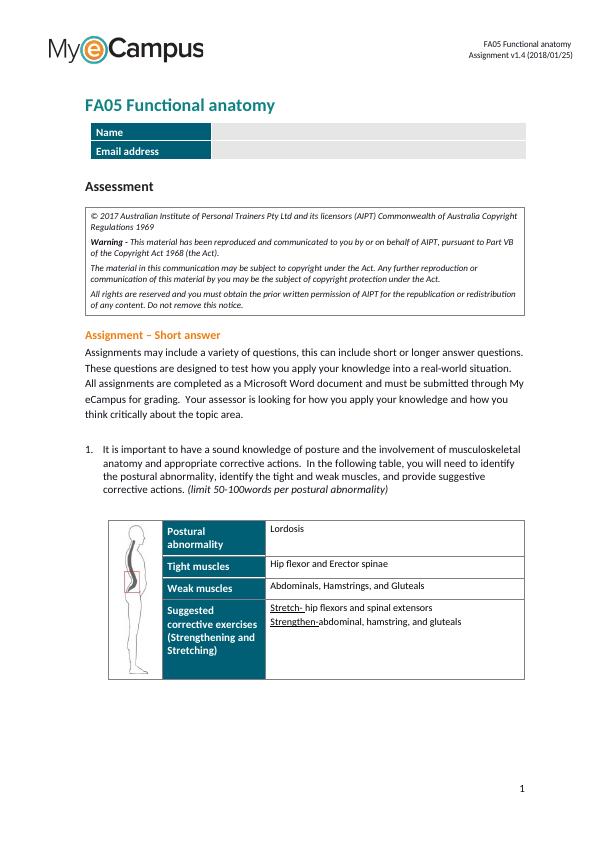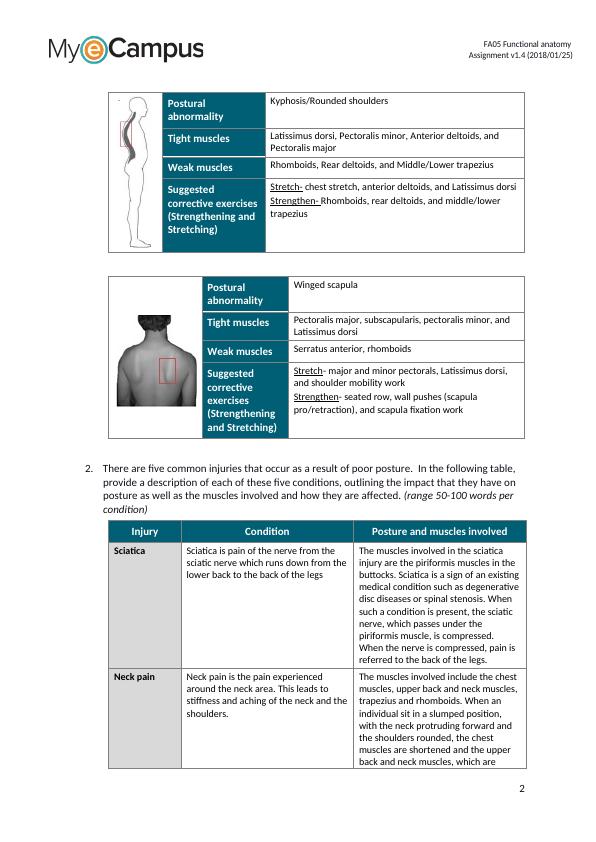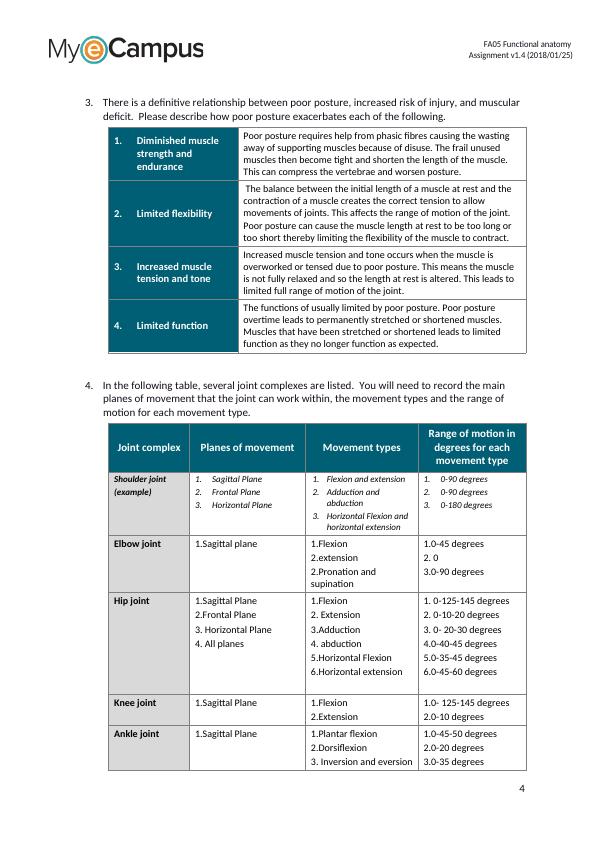Functional Anatomy Assignment: Posture, Injuries, Joint Complexes, Muscles, and Agility
Added on 2023-06-12
20 Pages7445 Words378 Views
FA05 Functional anatomy
Assignment v1.4 (2018/01/25)
FA05 Functional anatomy
Name
Email address
Assessment
© 2017 Australian Institute of Personal Trainers Pty Ltd and its licensors (AIPT) Commonwealth of Australia Copyright
Regulations 1969
Warning - This material has been reproduced and communicated to you by or on behalf of AIPT, pursuant to Part VB
of the Copyright Act 1968 (the Act).
The material in this communication may be subject to copyright under the Act. Any further reproduction or
communication of this material by you may be the subject of copyright protection under the Act.
All rights are reserved and you must obtain the prior written permission of AIPT for the republication or redistribution
of any content. Do not remove this notice.
Assignment – Short answer
Assignments may include a variety of questions, this can include short or longer answer questions.
These questions are designed to test how you apply your knowledge into a real-world situation.
All assignments are completed as a Microsoft Word document and must be submitted through My
eCampus for grading. Your assessor is looking for how you apply your knowledge and how you
think critically about the topic area.
1. It is important to have a sound knowledge of posture and the involvement of musculoskeletal
anatomy and appropriate corrective actions. In the following table, you will need to identify
the postural abnormality, identify the tight and weak muscles, and provide suggestive
corrective actions. (limit 50-100words per postural abnormality)
Postural
abnormality
Lordosis
Tight muscles Hip flexor and Erector spinae
Weak muscles Abdominals, Hamstrings, and Gluteals
Suggested
corrective exercises
(Strengthening and
Stretching)
Stretch- hip flexors and spinal extensors
Strengthen-abdominal, hamstring, and gluteals
1
Assignment v1.4 (2018/01/25)
FA05 Functional anatomy
Name
Email address
Assessment
© 2017 Australian Institute of Personal Trainers Pty Ltd and its licensors (AIPT) Commonwealth of Australia Copyright
Regulations 1969
Warning - This material has been reproduced and communicated to you by or on behalf of AIPT, pursuant to Part VB
of the Copyright Act 1968 (the Act).
The material in this communication may be subject to copyright under the Act. Any further reproduction or
communication of this material by you may be the subject of copyright protection under the Act.
All rights are reserved and you must obtain the prior written permission of AIPT for the republication or redistribution
of any content. Do not remove this notice.
Assignment – Short answer
Assignments may include a variety of questions, this can include short or longer answer questions.
These questions are designed to test how you apply your knowledge into a real-world situation.
All assignments are completed as a Microsoft Word document and must be submitted through My
eCampus for grading. Your assessor is looking for how you apply your knowledge and how you
think critically about the topic area.
1. It is important to have a sound knowledge of posture and the involvement of musculoskeletal
anatomy and appropriate corrective actions. In the following table, you will need to identify
the postural abnormality, identify the tight and weak muscles, and provide suggestive
corrective actions. (limit 50-100words per postural abnormality)
Postural
abnormality
Lordosis
Tight muscles Hip flexor and Erector spinae
Weak muscles Abdominals, Hamstrings, and Gluteals
Suggested
corrective exercises
(Strengthening and
Stretching)
Stretch- hip flexors and spinal extensors
Strengthen-abdominal, hamstring, and gluteals
1

FA05 Functional anatomy
Assignment v1.4 (2018/01/25)
Postural
abnormality
Kyphosis/Rounded shoulders
Tight muscles Latissimus dorsi, Pectoralis minor, Anterior deltoids, and
Pectoralis major
Weak muscles Rhomboids, Rear deltoids, and Middle/Lower trapezius
Suggested
corrective exercises
(Strengthening and
Stretching)
Stretch- chest stretch, anterior deltoids, and Latissimus dorsi
Strengthen- Rhomboids, rear deltoids, and middle/lower
trapezius
Postural
abnormality
Winged scapula
Tight muscles Pectoralis major, subscapularis, pectoralis minor, and
Latissimus dorsi
Weak muscles Serratus anterior, rhomboids
Suggested
corrective
exercises
(Strengthening
and Stretching)
Stretch- major and minor pectorals, Latissimus dorsi,
and shoulder mobility work
Strengthen- seated row, wall pushes (scapula
pro/retraction), and scapula fixation work
2. There are five common injuries that occur as a result of poor posture. In the following table,
provide a description of each of these five conditions, outlining the impact that they have on
posture as well as the muscles involved and how they are affected. (range 50-100 words per
condition)
Injury Condition Posture and muscles involved
Sciatica Sciatica is pain of the nerve from the
sciatic nerve which runs down from the
lower back to the back of the legs
The muscles involved in the sciatica
injury are the piriformis muscles in the
buttocks. Sciatica is a sign of an existing
medical condition such as degenerative
disc diseases or spinal stenosis. When
such a condition is present, the sciatic
nerve, which passes under the
piriformis muscle, is compressed.
When the nerve is compressed, pain is
referred to the back of the legs.
Neck pain Neck pain is the pain experienced
around the neck area. This leads to
stiffness and aching of the neck and the
shoulders.
The muscles involved include the chest
muscles, upper back and neck muscles,
trapezius and rhomboids. When an
individual sit in a slumped position,
with the neck protruding forward and
the shoulders rounded, the chest
muscles are shortened and the upper
back and neck muscles, which are
2
Assignment v1.4 (2018/01/25)
Postural
abnormality
Kyphosis/Rounded shoulders
Tight muscles Latissimus dorsi, Pectoralis minor, Anterior deltoids, and
Pectoralis major
Weak muscles Rhomboids, Rear deltoids, and Middle/Lower trapezius
Suggested
corrective exercises
(Strengthening and
Stretching)
Stretch- chest stretch, anterior deltoids, and Latissimus dorsi
Strengthen- Rhomboids, rear deltoids, and middle/lower
trapezius
Postural
abnormality
Winged scapula
Tight muscles Pectoralis major, subscapularis, pectoralis minor, and
Latissimus dorsi
Weak muscles Serratus anterior, rhomboids
Suggested
corrective
exercises
(Strengthening
and Stretching)
Stretch- major and minor pectorals, Latissimus dorsi,
and shoulder mobility work
Strengthen- seated row, wall pushes (scapula
pro/retraction), and scapula fixation work
2. There are five common injuries that occur as a result of poor posture. In the following table,
provide a description of each of these five conditions, outlining the impact that they have on
posture as well as the muscles involved and how they are affected. (range 50-100 words per
condition)
Injury Condition Posture and muscles involved
Sciatica Sciatica is pain of the nerve from the
sciatic nerve which runs down from the
lower back to the back of the legs
The muscles involved in the sciatica
injury are the piriformis muscles in the
buttocks. Sciatica is a sign of an existing
medical condition such as degenerative
disc diseases or spinal stenosis. When
such a condition is present, the sciatic
nerve, which passes under the
piriformis muscle, is compressed.
When the nerve is compressed, pain is
referred to the back of the legs.
Neck pain Neck pain is the pain experienced
around the neck area. This leads to
stiffness and aching of the neck and the
shoulders.
The muscles involved include the chest
muscles, upper back and neck muscles,
trapezius and rhomboids. When an
individual sit in a slumped position,
with the neck protruding forward and
the shoulders rounded, the chest
muscles are shortened and the upper
back and neck muscles, which are
2

FA05 Functional anatomy
Assignment v1.4 (2018/01/25)
Injury Condition Posture and muscles involved
responsible for pulling the shoulders
back are weakened. The rhomboids
and the trapezius are therefore forced
to work harder becoming achy and
tight as they try to keep the shoulders
back.
Patellofemora
l knee pain
This is pain that is felt at the front of
the knee.
The muscles involved are the
quadriceps muscles. The pain is
heightened by activities such as walking
down the hill or upstairs or standing up
after long hours of sitting. When there
is an imbalance between the
quadriceps muscles, the patella will
track laterally.
Lower back
pain
Lower back pain is the pain that is
experienced at the lower back due to
several factors such as trauma, poor
posture or overuse
The muscles that are involved include
the quadratus lumborum, and the
spinal erectors. When extra strain is
put on these muscles due to poor
posture, certain muscles such as the
flexor and extensor muscles are caused
to overwork leading to muscle spasms
and strains.
Shoulder
impingement
This injury is caused when shoulder
joint space is decreased leading to
pinching of any tendons that pass
through the space. The space is often
reduced due to poor posture
The muscles involved are the pectoralis
major, the pectoralis minor, the lower
trapezius, and the serratus anterior.
When a person sits for long periods
slouched at a desk, the chest muscles
become tight while the upper back
muscles become weak causing the
shoulder joint to lean forward.
3
Assignment v1.4 (2018/01/25)
Injury Condition Posture and muscles involved
responsible for pulling the shoulders
back are weakened. The rhomboids
and the trapezius are therefore forced
to work harder becoming achy and
tight as they try to keep the shoulders
back.
Patellofemora
l knee pain
This is pain that is felt at the front of
the knee.
The muscles involved are the
quadriceps muscles. The pain is
heightened by activities such as walking
down the hill or upstairs or standing up
after long hours of sitting. When there
is an imbalance between the
quadriceps muscles, the patella will
track laterally.
Lower back
pain
Lower back pain is the pain that is
experienced at the lower back due to
several factors such as trauma, poor
posture or overuse
The muscles that are involved include
the quadratus lumborum, and the
spinal erectors. When extra strain is
put on these muscles due to poor
posture, certain muscles such as the
flexor and extensor muscles are caused
to overwork leading to muscle spasms
and strains.
Shoulder
impingement
This injury is caused when shoulder
joint space is decreased leading to
pinching of any tendons that pass
through the space. The space is often
reduced due to poor posture
The muscles involved are the pectoralis
major, the pectoralis minor, the lower
trapezius, and the serratus anterior.
When a person sits for long periods
slouched at a desk, the chest muscles
become tight while the upper back
muscles become weak causing the
shoulder joint to lean forward.
3

FA05 Functional anatomy
Assignment v1.4 (2018/01/25)
3. There is a definitive relationship between poor posture, increased risk of injury, and muscular
deficit. Please describe how poor posture exacerbates each of the following.
1. Diminished muscle
strength and
endurance
Poor posture requires help from phasic fibres causing the wasting
away of supporting muscles because of disuse. The frail unused
muscles then become tight and shorten the length of the muscle.
This can compress the vertebrae and worsen posture.
2. Limited flexibility
The balance between the initial length of a muscle at rest and the
contraction of a muscle creates the correct tension to allow
movements of joints. This affects the range of motion of the joint.
Poor posture can cause the muscle length at rest to be too long or
too short thereby limiting the flexibility of the muscle to contract.
3. Increased muscle
tension and tone
Increased muscle tension and tone occurs when the muscle is
overworked or tensed due to poor posture. This means the muscle
is not fully relaxed and so the length at rest is altered. This leads to
limited full range of motion of the joint.
4. Limited function
The functions of usually limited by poor posture. Poor posture
overtime leads to permanently stretched or shortened muscles.
Muscles that have been stretched or shortened leads to limited
function as they no longer function as expected.
4. In the following table, several joint complexes are listed. You will need to record the main
planes of movement that the joint can work within, the movement types and the range of
motion for each movement type.
Joint complex Planes of movement Movement types
Range of motion in
degrees for each
movement type
Shoulder joint
(example)
1. Sagittal Plane
2. Frontal Plane
3. Horizontal Plane
1. Flexion and extension
2. Adduction and
abduction
3. Horizontal Flexion and
horizontal extension
1. 0-90 degrees
2. 0-90 degrees
3. 0-180 degrees
Elbow joint 1.Sagittal plane 1.Flexion
2.extension
2.Pronation and
supination
1.0-45 degrees
2. 0
3.0-90 degrees
Hip joint 1.Sagittal Plane
2.Frontal Plane
3. Horizontal Plane
4. All planes
1.Flexion
2. Extension
3.Adduction
4. abduction
5.Horizontal Flexion
6.Horizontal extension
1. 0-125-145 degrees
2. 0-10-20 degrees
3. 0- 20-30 degrees
4.0-40-45 degrees
5.0-35-45 degrees
6.0-45-60 degrees
Knee joint 1.Sagittal Plane 1.Flexion
2.Extension
1.0- 125-145 degrees
2.0-10 degrees
Ankle joint 1.Sagittal Plane 1.Plantar flexion
2.Dorsiflexion
3. Inversion and eversion
1.0-45-50 degrees
2.0-20 degrees
3.0-35 degrees
4
Assignment v1.4 (2018/01/25)
3. There is a definitive relationship between poor posture, increased risk of injury, and muscular
deficit. Please describe how poor posture exacerbates each of the following.
1. Diminished muscle
strength and
endurance
Poor posture requires help from phasic fibres causing the wasting
away of supporting muscles because of disuse. The frail unused
muscles then become tight and shorten the length of the muscle.
This can compress the vertebrae and worsen posture.
2. Limited flexibility
The balance between the initial length of a muscle at rest and the
contraction of a muscle creates the correct tension to allow
movements of joints. This affects the range of motion of the joint.
Poor posture can cause the muscle length at rest to be too long or
too short thereby limiting the flexibility of the muscle to contract.
3. Increased muscle
tension and tone
Increased muscle tension and tone occurs when the muscle is
overworked or tensed due to poor posture. This means the muscle
is not fully relaxed and so the length at rest is altered. This leads to
limited full range of motion of the joint.
4. Limited function
The functions of usually limited by poor posture. Poor posture
overtime leads to permanently stretched or shortened muscles.
Muscles that have been stretched or shortened leads to limited
function as they no longer function as expected.
4. In the following table, several joint complexes are listed. You will need to record the main
planes of movement that the joint can work within, the movement types and the range of
motion for each movement type.
Joint complex Planes of movement Movement types
Range of motion in
degrees for each
movement type
Shoulder joint
(example)
1. Sagittal Plane
2. Frontal Plane
3. Horizontal Plane
1. Flexion and extension
2. Adduction and
abduction
3. Horizontal Flexion and
horizontal extension
1. 0-90 degrees
2. 0-90 degrees
3. 0-180 degrees
Elbow joint 1.Sagittal plane 1.Flexion
2.extension
2.Pronation and
supination
1.0-45 degrees
2. 0
3.0-90 degrees
Hip joint 1.Sagittal Plane
2.Frontal Plane
3. Horizontal Plane
4. All planes
1.Flexion
2. Extension
3.Adduction
4. abduction
5.Horizontal Flexion
6.Horizontal extension
1. 0-125-145 degrees
2. 0-10-20 degrees
3. 0- 20-30 degrees
4.0-40-45 degrees
5.0-35-45 degrees
6.0-45-60 degrees
Knee joint 1.Sagittal Plane 1.Flexion
2.Extension
1.0- 125-145 degrees
2.0-10 degrees
Ankle joint 1.Sagittal Plane 1.Plantar flexion
2.Dorsiflexion
3. Inversion and eversion
1.0-45-50 degrees
2.0-20 degrees
3.0-35 degrees
4

End of preview
Want to access all the pages? Upload your documents or become a member.
Related Documents
FA05 – Functional Anatomy Assignmentlg...
|28
|10026
|30
Functional Anatomy for Corrective Exercises and Fitness Traininglg...
|33
|6089
|223
